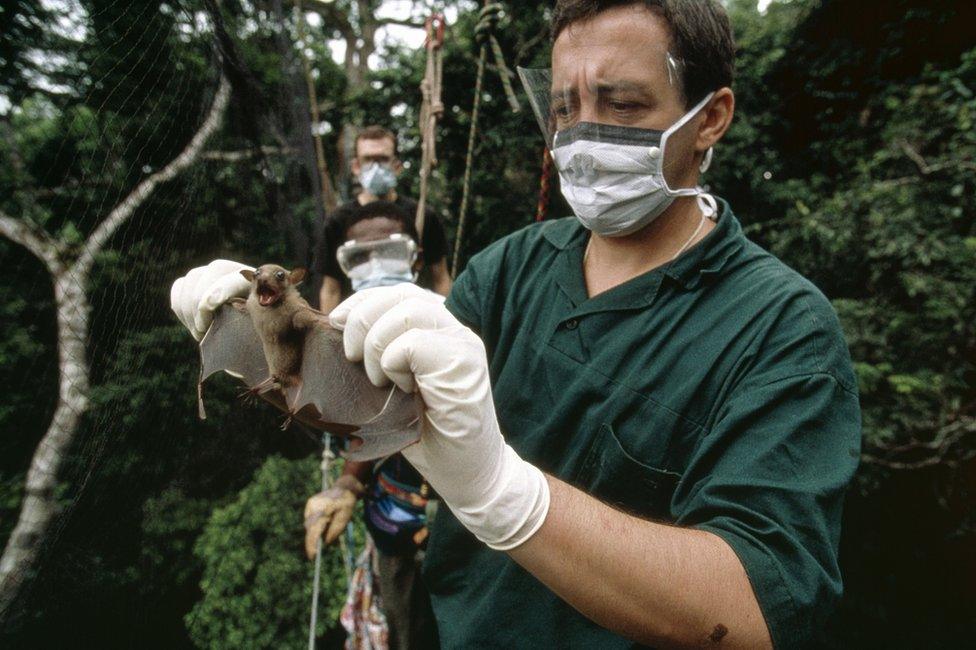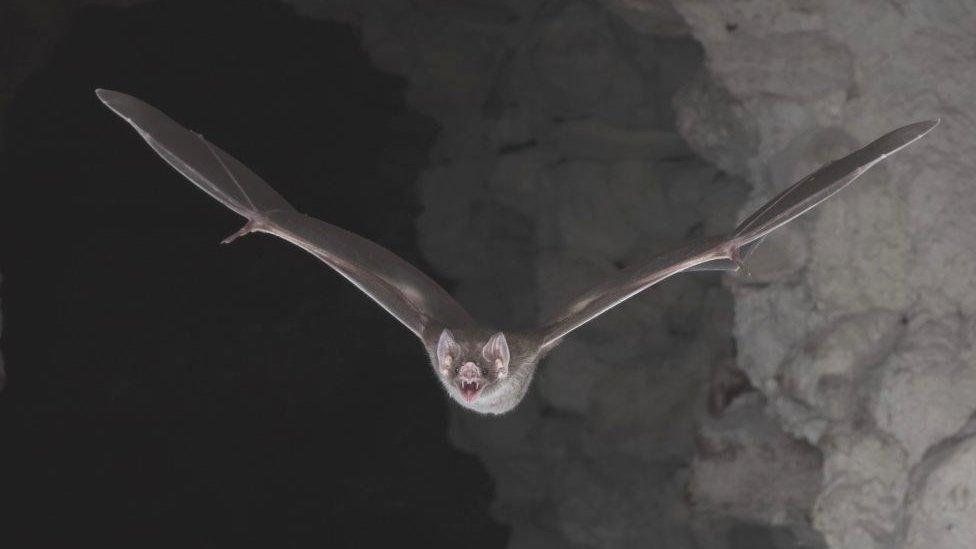Mutation 'gives bats edge over deadly viruses'
- Published

Bats can carry lots of deadly viruses, such as Nipah, Marburg, Sars and Ebola
A single mutation in an immunity gene called Sting might be one reason why bats can resist the worst effects of harmful viruses such as Ebola.
Chinese scientists have shown that bat Sting triggers production of lower levels of interferon, the proteins that signal when the body is under attack.
Too much interferon is associated with the serious symptoms seen in many virus infections.
But bats, through their mutation, have evolved a means to dampen the response.
The researchers also think that the Sting gene has evolved to cope with the potentially harmful effects of flight.
Their study is published in the Journal Cell Host and Microbe, external.
Bats carry lots of deadly viruses, like Nipah, Marburg, Sars and Ebola, without suffering from ill-effects.
And Prof Peng Zhou, from the Wuhan Institute of Virology, was intrigued by this resilience.
"We were interested why and how bats’ immune systems could deal with so many deadly viruses," he told BBC News.
Usually when we think of immunity to viruses we tend to think about antibodies and a set of T cells called killer T cells.
These recognise and destroy specific viruses that they have been trained to see, either through past infection or vaccination.
But an important arm of our immune system, and one that Prof Zhou and his colleagues focussed on, is able to fend off viral invaders without ever seeing them before – so called innate immunity.
Sensing danger
When a virus infects a cell it leaves a variety of tell-tale signs and these rogue virus molecules are detected by sensor proteins that switch on production of interferon.
The early symptoms that we associate with a virus infection – fever, aches and tiredness – are all caused by the effects of interferon.
When interferon is produced, it triggers creation of other molecules that have a direct antiviral effect.
We can think of innate immunity as a cascade of powerful virus killing effects. But too much interferon can be damaging and is thought to be one of the reasons why some viruses, like Ebola and Sars, cause really serious illness.
“At the start, we thought that the bat might have a super-strong innate immune system which meant that their interferon could kill all the virus, but later on after the bat genome and a number of other studies, we started to think that there might be something special, and that they were in balance with the virus," Prof Zhou explained.
He said that this previous work had hinted that whilst some parts of the anti-virus cascade were ramped up, others were dampened down.
One of the genes that might be diminished is called Sting.
Flight of fancy
Sting is an important defence against the invasion of DNA viruses and it does this by detecting DNA in the place where it should not normally be found – in the cytoplasm of the cell.
Some studies have also suggested it can detect RNA too – an alternative genetic material often used by viruses.
An animal cell can be divided into two main compartments: the nucleus and the cytoplasm. Inside the sea of cytoplasm is a range of specialist factories including the power plants of the cell known as the mitochondria.
In a healthy cell, DNA is locked away in the nucleus and mitochondria, but the scientist had a hunch that the exertion of flight would damage DNA, which might leak into the cytoplasm.
And Prof Zhou thought that this might help shape evolution of the bat Sting protein: "We believed that this free DNA as well as DNA viruses may shape the bat genome so that it shifts the Sting pathway in bats so that less interferon is produced, because too much interferon production is not good," he said.
Their initial experiments confirmed that switching on bat Sting resulted in lower levels of interferon than the human version.
Then, by comparing Sting gene sequences between bats and other mammals, the Chinese team was able to identify a single difference in the protein's amino-acid building blocks. At a key location – called S358 - all the non-bat species had a serine amino acid, whilst the bats did not.
Further work
When Prof Zhou and his team mutated bat Sting to contain a serine at S358, interferon production increased. But, when they replaced the serine in the human protein to a different amino acid then lower amounts of interferon were produced.
This was true if interferon production was switched on using chemicals or when the cells were infected with a DNA-containing virus called herpes simplex.
Commenting on the findings, Prof Victor DeFilippis from the Oregon Health and Science University, US, said "I'm not sure that you can draw broad conclusions that a dampened Sting-dependent interferon response is allowing bats to harbour a large array of viruses.
"For one thing, this pre-supposes that Sting-mediated anti-viral activity is detrimental to the host. But an opposite case could just as easily be made – that optimal Sting function is necessary to protect against pathogenic viruses.
"Importantly, there are no ‘smoking-gun’ mechanistic studies that indicate Sting is a direct or indirect factor in increased viral occupation of bat species."
And Prof Alexander Bukreyev, who is based at the University of Texas Medical Branch, wondered if the findings would be relevant for viruses that have an RNA genome.
He told the BBC: "This is an important step toward understanding why bats harbour multiple viral pathogens. But some published studies demonstrate that treatment of bat cells with various stimuli or infection with viral pathogens such as Ebola and Marburg... do produce quite robust interferon response. This apparent discrepancy can be explained by multiple redundant pathways triggering the interferon response.
"Clearly, more studies are required to better understand the ability of bats to harbour viral pathogens."
And Prof Zhou agrees that more work is needed: "What we see may be an adaptation to flight or to allow the bats to carry more DNA or RNA viruses. In this study, we focussed on DNA sensing and whilst RNA sensing is likely to be dampened, we have to prove that in future studies."
- Published19 February 2018

- Published19 November 2013

- Published30 October 2013
